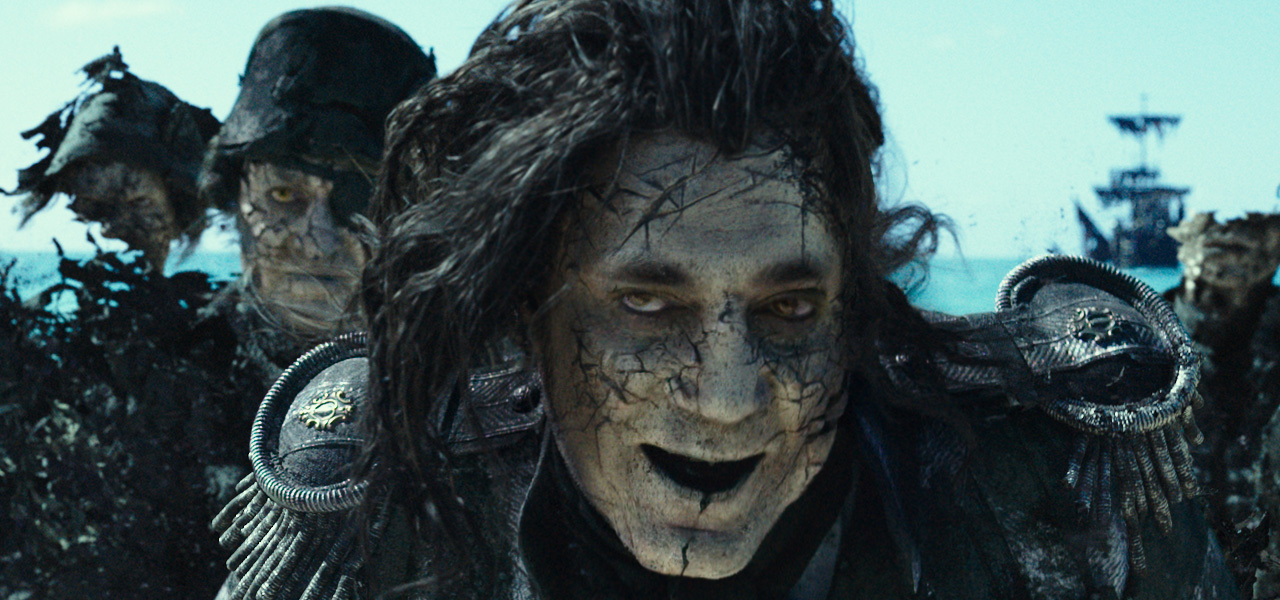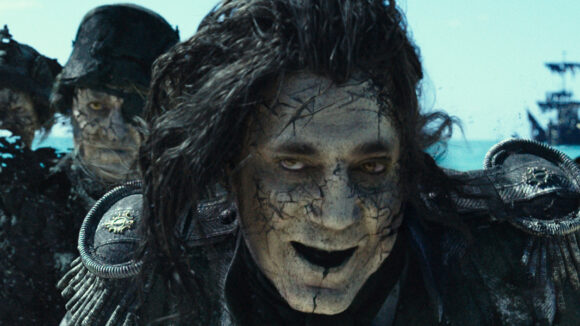

Just How Did They Make Javier Bardem Look Like He Was Underwater in ‘Dead Men Tell No Tales’?
Jarvier Bardem is on screen a lot in Pirates of the Caribbean: Dead Men Tell No Tales. Which wouldn’t really be a big deal at all except for the fact that, most of the time, it looks like he’s underwater.
Bardem’s character, the undead Captain Salazar, is part of a crew that suffers horrendous injuries and is cursed to remain undead. It means the crew appears with face and body parts missing. Salazar’s hair and clothing, in particular, sways as if he remains under the sea.
That final underwater look for Salazar was the result of on-set makeup effects, including the incorporation of bluescreen patches and tracking markers, and a major visual effects effort by MPC to remove and augment facial features and simulate hair and clothing. Patrick Ledda, a visual effects supervisor from MPC on the film, tells Cartoon Brew more.
Shooting Salazar
The transformation of Bardem began during filming, which took place on the Gold Coast in Australia. The actor wore tracking markers and had his hair tied back – it would be fully replaced with cg simulated hair. He was then subject to hours of meticulous prosthetic application carried out by Odd Studio, including specific crack-like markings. In order to enable a gaping hold in the side of his face, a bluescreen patch was included in the makeup effects design which MPC would ‘fill in’ later.

On set, Bardem and the other undead crew performed their scenes with a “slow motion lag kind of behavior as if they were underwater,” explained Ledda. This would take place in partial costumes, occasionally with some gray-colored pieces or tracking pieces, which MPC would augment in post.
That performance became the basis of MPC’s take-over into digital. But first the studio had to engage in roto-animation of Bardem and the other actors to track and match their behaviors and movement. “Once we had these characters roto-animated we then applied our digital costumes on top which had damaged and burnt areas and lots of rips,” said Ledda. “And then our technical animators took over and they applied these cloth sims and hair simulation to give it this kind of underwater feel.”

Handling hair
When it came time to add Salazar’s cg hair, Ledda notes that MPC initially had two challenges. One was that any simulation had to match Bardem’s actual on-set movements – which in general were ‘real-time’ – while the other was that the hair would need to look like it was underwater, which generally makes things appear slowed down. The solution would have to be one that ‘looked’ correct but could be altered as needed from shot to shot.
After a number of tests, MPC devised an approach that let artists produce a physically correct hair simulation, following ‘grooming’ with their proprietary hair tool Furtility, while also allowing for creative control. This control came in the form of posing the hair in certain frames. “If we wanted a specific chunk of hair over his nose or some sort of hair rolling back, we could actually pose that and then have our simulation take that into account and be gently dragged towards certain keyframes, almost as if there was a sort of field or current that kind of leads it towards these kind of keyframes,” said Ledda.

The groom itself for Salazar was made up of fine hair, damaged hair, and a number of dreadlocks. The ‘dreads’ had to behave differently for their underwater look than the fine hair, but everything was also intertwined and tangled, with many, many knots.
Another interesting challenge was maintaining continuity. Ledda notes that animators are used to working in beats. “They usually work on maybe three or four shots at the same time, so we can actually see how a character works across a cut. But because this was more technical animation, it wasn’t so beat-oriented.”

“The difference here,” said Ledda, “was that we had to run all these hair simulations across multiple shots, because if the hair is ‘screen left’ in the previous shot, obviously it has to be in the same place in the following shot. It’s quite tricky when you’re simulating hair because you can end up with many cuts. To run a simulation across say 20 shots and making sure it all feels coherent was definitely a big challenge.”

.png)